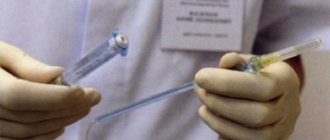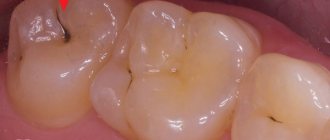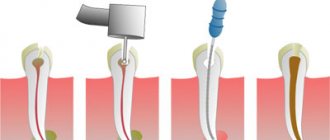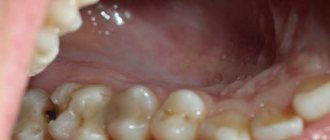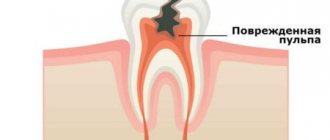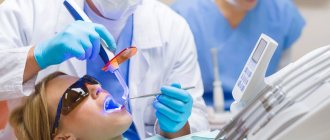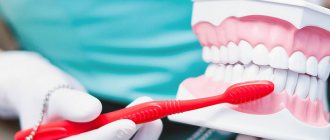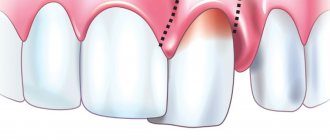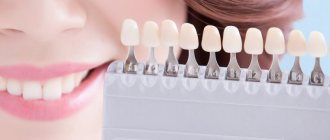Types of caries localizations
Caries (lat. caries rotting) is a slow and hidden pathological process occurring in the hard tissues of the tooth. It is characterized first by focal demineralization of the enamel, then by the destruction of hard tooth tissues with the appearance of a cavity in the dentin. If left untreated, the tooth is lost or complications arise - pulpitis and periodontitis.
Cervical (circular)
The structure of a tooth is divided into a root, a neck and a crown - the latter is located above the gum. The neck and root are located in the gum and are protected by soft mucosal tissue.
When the carious process begins to destroy the tooth in the area of contact of the crown with the mucous membrane, we can talk about the cervical form of caries.
This category is the most difficult to diagnose and treat. It most often affects the incisors. When biting food with incisors, the food is not only “cut off”, but also gets clogged into the gum pockets, moving towards the gums.
Crown caries
Caries has the ability to affect not only healthy, but also already treated teeth - under a filling or crown. If there is a crown, it is difficult to detect, because the tooth does not have a nerve and pain is not felt. There are no external signs for a long time.
The causes of this type of caries are:
- defect of the dental crown with the appearance of access to the tooth tissue underneath it
- poorly treated tooth before prosthetics;
- gum disease;
- poor oral hygiene.
The problem is that the process spreads into the deep layers and spreads to the bone structures, as a result of which the tooth is often completely removed. That is why preventive examinations and an orthopantomogram - a panoramic image of the entire jaw - are so important.
Radical caries
Basal and cervical caries are similar. Both incisors and chewing teeth are affected. Destruction begins with the enamel, gradually moving to the nerve in the root canal. When the process touches bone tissue, it threatens with osteomyelitis.
The main reason for the occurrence is a cariogenic situation in the oral cavity, when plaque accumulates especially quickly. The enamel in the root part of the tooth is much thinner and more easily destroyed. It is most often diagnosed between the ages of 30 and 60 years.
Root caries
Root or subgingival caries occurs hidden. It can be with or without a cavity. Along the flow - active, suspended, secondary. It most often affects molars.
What is the danger of this disease?
Caries is dangerous because there are no symptoms for a number of years. It is detected more often in an advanced stage, when tooth extraction becomes the solution.
Visual diagnosis is difficult because all destructive processes occur inside the tooth. Pronounced plaque or tartar hides any stains on the enamel.
The root is hidden under the gum and external irritants do not affect it until a certain time. On the other hand, the root walls are thin, so they are destroyed quickly and with complications.
Causes of the disease
There are 3 main provoking factors that must act in a complex manner; none of them acts independently:
- Cariesogenic microflora - this includes Mutans streptococci, actinomycetes and certain types of lactobacilli. They should dominate the oral cavity. Bacteria produce organic acids from food carbohydrates, which cause demineralization of cement.
- Consumption of simple carbohydrates is the most cariogenic. Their breakdown produces glucan, which contributes to the appearance of plaque.
- Reduced caries resistance is a deterioration in the resistance of tooth tissue and the body as a whole. This is facilitated by a decrease in calcium content in hard root tissues, bad habits, and lack of saliva.
In addition, the anatomical features of the mouth can also have an effect - a small vestibule, a short frenulum, and bite pathology.
Gum disease, pocket formation
Gum pocket or otherwise periodontitis is a common occurrence in many patients. Many people do not treat it because it does not bother anyone for a long time.
The first manifestation of pathology is bleeding when brushing teeth, although outwardly they may look healthy. Dental pockets or depressions are normal, but their anatomical size should not exceed 3 mm.
Then the pocket is able to self-clean from food debris and epithelial particles. Reservoirs of bacterial accumulations form in deep gaps. This is accompanied by bad breath. Conventional treatment with antibiotics and brushing teeth with toothpaste have no effect.
Causes of periodontitis:
- insufficient hygiene;
- poor quality fillings;
- abnormal position of the dentition, malocclusion;
- hereditary predisposition;
- deficiency of vitamins and minerals;
- immunosuppression.
Orthodontic stage: bite correction
A physiologically correct bite is one of the important criteria for a Hollywood smile. According to statistics, malocclusion occurs in 90% of patients. These can range from minor problems to serious pathologies. In any case, if you decide to get a Hollywood smile, you cannot do without consulting an orthodontist.
Getting a beautiful smile doesn't always require wearing braces. Minor deviations can be corrected by other methods. After the examination, the orthodontist will give you his recommendations on the optimal methods of treating the bite in your case.
Mouth guards for bite correction
One of the correction methods is treatment with mouth guards. A set of mouth guards is made from dental impressions, individually for each patient. The polymer is soft but elastic. The mouthguard puts pressure on the teeth, so they begin to gradually move. But unlike braces, the pressure is gentle. Creating a Hollywood smile takes place without discomfort. Due to the fact that the polymer is transparent, the aligners are not visible on the teeth even when smiling.
Treatment with mouthguards has one peculiarity. The effectiveness of the correction directly depends on how carefully you follow the orthodontist’s recommendations. If you are not ready for this, it is better to use other orthodontic methods to create a beautiful smile.
It's easy to use mouthguards:
- Wear it on your teeth daily, for a period of time calculated by the doctor when developing a bite correction plan.
- As the teeth move into the desired position, the set must be replaced with a new one.
The number of sets required to create an ideal smile will also be determined by the orthodontist at the preparatory stage.
Correction with braces
Braces are one of the most effective methods for treating malocclusion and creating a beautiful smile. It can be used even for serious pathologies. The correction period depends on the complexity of the case.
Traditional metal braces had one serious drawback - they spoiled the appearance of your smile. This caused psychological discomfort for many patients, and some refused treatment because of it. Modern braces are made from different materials. They look aesthetically pleasing on the surface of the teeth, and during long-term orthodontic treatment your smile will be beautiful, you won’t have to be embarrassed.
We offer braces from different materials: ceramic, sapphire. They will cost more than metal ones, but if a beautiful smile is important to you, it is better to opt for them.
Depending on the type of pathology, the doctor will offer you one of the types of braces:
- Lingual. They are fixed on the inner surface of the teeth, so they are absolutely invisible while wearing. Such systems are suitable for the treatment of serious pathologies.
- Vestibular. The brace lock is installed on the outside of the teeth and the arch is fixed to them.
Vestibular braces also differ in the method of correction. In ligature systems, the arch is fixed using ligatures. When the teeth move, the doctor adjusts the position of the arch. Self-ligating systems do not require correction.
Traditional metal braces are still used in orthodontics and can successfully treat malocclusions. When creating a Hollywood smile, we can recommend them if quick results are more important to you than aesthetics during treatment.
Lifestyle
If you have learned about the risk group for root caries (older age), this does not mean that you can relax. Caries has many causes and can occur at any age if basic precautions are not followed.
Those at risk include smokers, diabetics, pregnant women and even children. The provoking factors in this case are:
- smoking and lack of oral hygiene;
- infrequent brushing of teeth and lack of fluoride;
- poor nutrition with preference for desserts;
- frequent stress;
- alternating hot and cold;
- structural features of the oral cavity;
- alcohol abuse - alcohol breaks down into sugars and acids;
- abuse of coffee and strong tea, which creates an acidic environment in the oral cavity;
- lack of water intake, and therefore lack of saliva;
- gum injuries.
How much does a Hollywood smile cost?
It is impossible to answer definitively the question of how much it will cost to create a Hollywood smile. It all depends on the source data. Doctors of different specialties often participate in the work - therapists, hygienists, orthodontists, orthopedists, implantologists. The better the condition of your teeth and oral cavity, the cheaper a perfect smile will cost. In rare cases, all procedures end with professional hygiene and whitening.
Additional treatment always increases costs. The final cost of a beautiful smile is determined by several factors:
- Type of treatment;
- Volume of medical procedures;
- Technologies used;
- Types of orthopedic and orthodontic structures used, etc.
To find out the exact cost of your new smile, come for a consultation with a dentist at our clinic. If necessary, the doctor will refer you for examination and consultation with specialized specialists. After this, we will be able to calculate the prices of all procedures necessary to create a Hollywood smile.
Symptoms of the disease
The process usually occurs without symptoms, but pain may occur when brushing a toothbrush, eating sour, salty, sweet, cold or hot foods.
After eliminating the irritant, everything goes away. The patient can see a doctor if a stain is found on the front surface of the incisors, but often it is hidden under plaque or tartar.
The ongoing carious process gradually reaches the dentin junction, penetrating first into its surface layers and then further. The cavity deepens with bacteria and food debris. There is a smell from the mouth. Irritants cause pain more and more frequently.
With cement caries, teeth become mobile and lose their support, and bleeding gums occur. These are already symptoms of periodontitis. Now, even when chewing food or brushing teeth, severe discomfort occurs.
Digestion begins to suffer. Teeth become hypersensitive to hot or cold.
Next, the process follows the Leus classification:
- Active lesion - the edges of the cavity are undermined. The cavity is filled with softened tissues and tends to grow.
- Suspended caries - no increase in the affected area is observed. The cavity is clean, the bottom is shiny and smooth, the edges are even and dense.
- Secondary caries - occurs under a filling.
Crack on front tooth
The front teeth always get the most damage. When they “punch you in the teeth,” the blow usually falls on them. They fell unsuccessfully, worried, chewed a pencil, or, horror of horrors, chopped nuts with their incisors, and now a crack appeared on the front tooth. By the way, it can occur without mechanical damage - for example, due to temperature changes. Teeth don't really like iced coffee. You shouldn’t overuse citrus fruits or their juices either, and it’s best to dilute freshly squeezed juices with water to reduce their acidity. You should not get carried away with whitening procedures, and be more careful with abrasive pastes. Cracks are also different.
Vertical
If you are “lucky” and it is small vertical, then nothing bad will happen to this tooth, and the defect will be barely noticeable. In this case, many dentists do not recommend loading the tooth with patches. But you still need to keep an eye on the crack. If it increases, the enamel changes color, and the tooth reacts sharply to hot/cold, sweet/salty, you should consult a dentist. The enamel will need to be restored and strengthened. The crack will be treated with a special compound containing calcium and fluorine. After the course of treatment, the tooth will react normally to food and become more even and smooth.
Horizontal
But horizontal or oblique cracks in the front teeth are a cause for serious concern. They provoke the formation of caries, chips and can generally lead to tooth loss. Treatment depends on the size, depth and location of the crack, as well as the characteristics of the enamel. If there are many microcracks on the tooth and the color of the enamel has changed, the doctor may suggest installing veneers, but only after treating caries and other oral diseases. A crack left unattended will permanently split the tooth. Then there will only be one treatment option left - prosthetics.
Diagnosis of the disease
The diagnosis is made in stages. Listening to complaints and visual examination make it possible to diagnose caries only in 13% of cases. Classic probing with a sharp probe and inspection with a mirror are informative. This allows you to examine the dentition.
Thermal diagnostics, electroodontometry and x-rays are also performed. If the patient has massive dental plaque, changes in the enamel will not be visible. In this case, professional teeth cleaning is first carried out to remove plaque and stone. All this is possible in a dental clinic.
At the dental clinic
The following types of studies can be performed at the clinic:
- Probing with a thin probe with a curved end - it is inserted under the gum, while the doctor has the opportunity to examine the structure of the tooth, its integrity, the presence of irregularities and chips. With rapidly progressing caries, the edges of the cavity are uneven and sharp. In the remission stage, the surface of the pathological focus is shiny, smooth, hard with smooth edges.
- Electroodontometry - can determine nerve damage and the depth of inflammation. The pulp reacts differently to the current strength.
- Thermal diagnostics - treatment of different areas of the tooth with a stream of water and heated wax. Unpleasant sensations that disappear after removing the irritant indicate caries.
- X-ray - a targeted photograph of one tooth or computed tomography. The presence and localization of obvious or hidden inflammation is determined with millimeter precision.
- Visiography is a special device - a visiograph scans the received data and transfers it to a computer, where the picture is studied from different angles and in detail, revealing the hidden process of inflammation.
Preparation for treatment with braces, veneers and aligners
| Preparing for treatment | ALINERS | BRACKETS | VENEERS |
| Virtual setup: a computer program allows you to create a three-dimensional model of the dental system | Yes | No | Yes |
| Opportunity to discuss the results and progress of treatment with the doctor | Yes | No | Yes |
| Patient participation in treatment | Yes | No | No |
When a patient sees on the computer his future smile, in which all the teeth are aligned, it seems fantastic. But in fact, the 3D virtual setup is a super program from Star Smile, considered one of the best in the world and used by clinics in more than 25 countries
world and
100 cities of Russia
. This program for visualizing the future result of treatment using more than 40 parameters simulates all processes of bite correction and allows you to accurately plan treatment. Exactly with the same great result that the patient will see BEFORE the start of treatment.
Braces do not have this option - all treatment is carried out blindly, and the patient can only live in hope for the future.
And a huge plus in preparing and conducting treatment is the participation of the patient. The aligners are removable and are completely under the control of the person being treated. Therefore, the answer to the question: “What is better - braces or aligners at the initial stage?” — aligners.
Treatment or removal - what determines the outcome
The doctor makes a decision on treatment or tooth extraction after determining the depth of spread and the area of localization of the inflammatory process. It is mandatory to first carry out professional cleaning using an ultrasonic scaler, an AirFlow water-abrasive device and hand tools.
Initial caries is treated with conservative retherapy. For hard tissue defects, preparation and filling are performed. In severe cases, the tooth is removed.
Treatment of the initial stage of root caries
Conservative retherapy includes:
- fluoridation of teeth;
- covering teeth with protective agents
- training in proper oral hygiene
If your front tooth hurts after treatment
Patients often complain that their front teeth hurt after treatment. The dentist cleaned the canals, so this is normal. The discomfort should go away within a few hours. But if the treatment is done poorly, the tooth may hurt for a long time - and this is already a deviation from the norm. Most likely, the doctor made a mistake during treatment and the entire filling process will have to be repeated. The cause of pain can be a burn of the pulp, damage to the enamel, an allergy to medications, or acid contact with dentin.
Cleaning in dentistry from stone and plaque
1243900247100
Professional teeth cleaning involves removing the accumulation of all pathogenic microflora around the root.
It involves not only removing plaque, but also stones. This elimination of negative factors protects teeth for a long time.
Antiseptic treatment of affected areas
Treatment of root caries involves drilling out all affected areas with a drill and treating the carious cavity with antiseptics and special preparations. A 2% chlorhexidine solution or a gel based on it is used as an antiseptic for the treatment of carious cavities.
What to do to protect your gums
If the gum is not treated, inflammation will remain and all treatment will become meaningless. The gums are protected by diathermocoagulation and retraction.
Diathermocoagulation
Diathermocoagulation – excision of excess areas of periodontitis with a coagulation knife. The knife immediately cauterizes the bleeding edges. The procedure is performed when there are severe changes in the gums. In such cases, filling is postponed until the soft tissue is completely regenerated.
Retraction
If the condition of the gums is advanced, treatment of caries becomes impossible - the mucous membrane bleeds and interferes with tooth treatment. This gum is excised or a special device is applied to move the gum back. But more often, retraction is performed - lowering the gingival contour or moving apart the overhanging edges of the gums using special hemostatic threads. A temporary filling is placed until complete healing.
What preventative measures are there?
To keep your teeth healthy for many years, you need to brush your teeth twice a day, use floss and a tongue scraper. After sweets, you should rinse your mouth and chew gum for 5-10 minutes.
Prevention also includes the removal of tartar. A sufficient amount of saliva is also important, so it is necessary to maintain a water regime.
Like any other pathology, caries is better prevented than treated. Therefore, it is important to visit the dentist twice a year for preventive examinations. People at risk should approach this especially responsibly.
